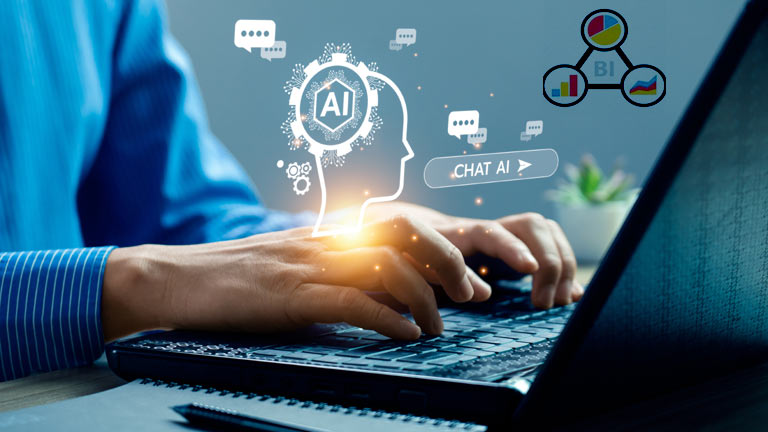
In today’s fast-moving business world, information is key, and understanding it can lead to success. Think of data as modern gold and two tools that help you mine this gold are Artificial Intelligence (AI) and Business Intelligence (BI). They might sound technical, but they’re here to change the way businesses make decisions. But wait, what are AI and BI, and how do they work hand in hand? Let’s dive in and explore this dynamic duo.
Understanding AI and BI
AI – The Wizard of Insight:
AI is like the wise wizard of the data world. It refers to machines that can perform tasks that typically require human intelligence. These machines use algorithms to analyze vast datasets, identify patterns, and learn from them. This makes AI a powerful tool for predicting future outcomes and providing valuable insights.
BI – The Sherlock of Data Analysis:
Think of BI as the detective of data analysis. It’s a lot like Sherlock Holmes, using software to gather, shape, and show data from different places. BI’s main job is to make data easy to understand so that businesses can make decisions based on what happened before and what’s happening now.
Usually, It’s AI vs. BI
Typically, it’s artificial intelligence vs. business intelligence due to their inherent differences in approach and application. Business Intelligence (BI) primarily deals with historical data analysis, generating reports, and creating dashboards to provide insights into past performance. It focuses on what happened and why it happened, offering a retrospective view.
Now, AI is more about looking ahead. It tries to predict what might happen next by looking at patterns and trends in big chunks of data. AI uses things like complex math, machine learning, and automation to find these patterns, even without being specifically programmed to do so.
While BI focuses on analyzing what’s occurred and what’s currently happening, AI aims to forecast future events. Some believe that investing in AI is the path to the future, as it can autonomously make decisions and provide real-time analysis. Conversely, others argue that enhancing BI is a more prudent approach, as it enables you to comprehend past events, allowing for more informed decisions grounded in historical understanding.
The Power of Synergy: How AI and BI Complement Each Other:
Data Collection and Preparation:
AI can assist BI by automating the process of data collection from multiple sources, eliminating the need for manual interventions.
BI, in turn, can ensure data quality and prepare it for analysis, so AI has a clean canvas to work on.
Advanced Analytics:
AI can unleash its prowess in advanced analytics by identifying hidden patterns, correlations, and trends that might not be apparent to human analysts.
BI can then translate these findings into visually engaging dashboards and reports, making complex data accessible and actionable for business users.
Personalization:
AI can personalize user experiences by understanding individual preferences, leading to better-targeted marketing and higher customer satisfaction.
BI can take these personalized insights to optimize product offerings, pricing strategies, and marketing campaigns, ensuring maximum ROI.
Use Cases: How AI and BI Work Hand in Hand in Real Life
Predictive Maintenance:
AI can predict when equipment might fail based on historical data and sensor readings, allowing companies to perform maintenance proactively.
BI can create maintenance schedules and monitor equipment performance, reducing downtime and saving costs.
Customer Segmentation:
AI can segment customers based on their behaviors and preferences, enabling targeted marketing campaigns.
BI can track the effectiveness of these campaigns, measuring customer response and fine-tuning marketing efforts accordingly.
Overcoming Challenges
Data Security and Privacy:
With great power comes great responsibility. AI and BI must work together to ensure data security and protect sensitive information.
Implementing robust encryption, access controls, and anonymization techniques can address these concerns.
Interpreting AI Results:
AI algorithms can sometimes be difficult to interpret, making it challenging for business users to trust the insights.
BI can bridge this gap by presenting AI results in a clear and understandable manner, providing context and explanations.
The Future: Unleashing the Full Potential
The journey of AI and BI has only just begun, and the future looks incredibly promising:
AI-Driven BI:
AI will take over more aspects of BI, automating data preparation, visualization, and even generating insights without human intervention.
BI tools will become more intuitive and user-friendly, allowing business users to leverage AI’s power effortlessly.
Augmented Analytics:
AI-powered analytics will become more prevalent, guiding business users through data exploration and recommending the best visualizations for their needs.
This will empower non-technical users to be more data-savvy and make data-driven decisions
confidently.
Conclusion
AI and BI are like two halves of a whole, each contributing unique strengths to empower businesses and drive growth. As they continue to evolve and work hand in hand, we can expect a future where data-driven decision-making becomes the norm, and businesses thrive in the ever-changing landscape. So, embrace this perfect pairing and unlock the full potential of your data-driven destiny!



